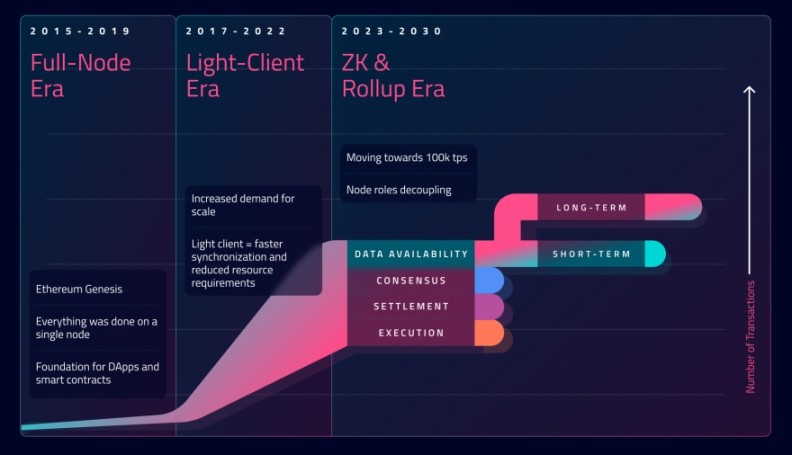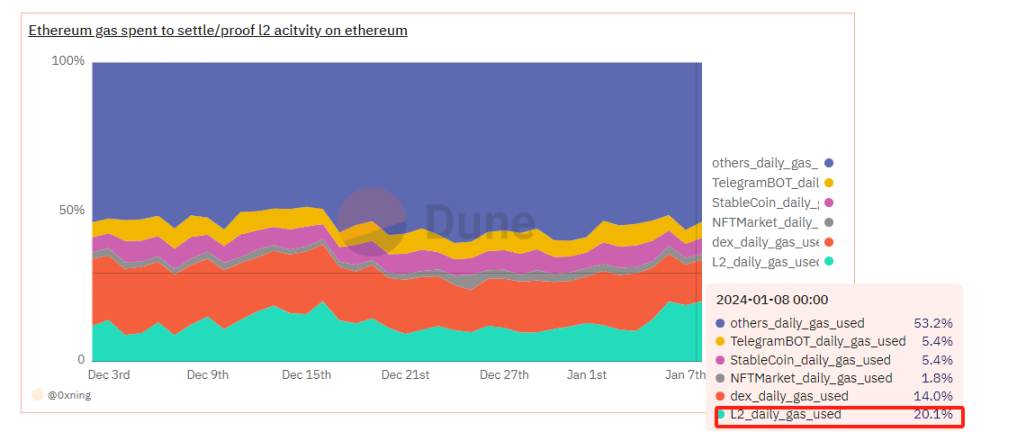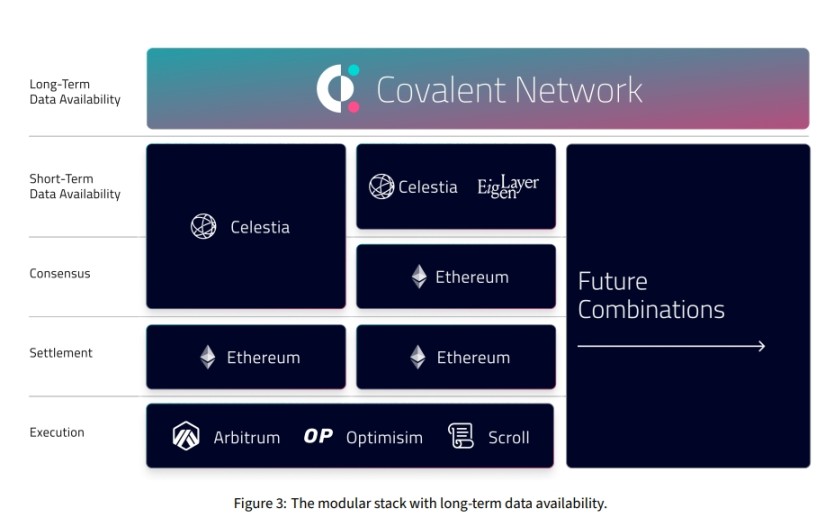After the Cancun upgrade, modular public chains may become the mainstream paradigm of public chains, and the DA layer will become the most fiercely competitive area in the modular stack, and the DA War will be in full swing.
Author: NingNing
In the first half of this year, after the Ethereum completed the Cancun upgrade, Ethereum will complete the prototype stage of transitioning from a monolithic blockchain to a modular blockchain.
After the Cancun upgrade, Ethereum can be seen to a certain extent as a modular public chain system composed of Ethereum mainnet as L1 and L2 based on Ethereum (Arbitrum, Optimism, ZkSync, Starknet, Scroll, Taiko, Metis, etc.).
From the pursuit of complete equivalence of Ethereum, as indicated by Optimism's slogan "Ethereum, scaled," we can see the profound changes.
After the Cancun upgrade, the Ethereum stack will be explicitly divided into consensus layer, data availability layer, settlement layer, and execution layer. The execution layer's functionality will be partially (Danksharding may be entirely) outsourced to L2 based on Ethereum, the data availability layer will ensure the rebuildability of L2, the settlement layer will ensure the asset security of L2, and the consensus layer will be responsible for final determinism.

DA (Data Availability) refers to the Rollup of L2's state data, including transactions, to L1, which is stored on the L1 mainnet after verification and consensus, providing fraud proofs for Op-Rollup L2 and ZKP verification support for ZK-Rollup.
Currently, L2's state data is stored in the form of CallData in Ethereum mainnet blocks. After the Cancun upgrade, L2's state data will be stored in the newly added Blob space.

Currently, the gas fees for L2 verification and settlement consume 10-20% of Ethereum mainnet gas consumption. The fees paid to Ethereum mainnet for DA services account for 95% of L2 gas fee consumption.
Before the modular public chain Celestia, which focuses on providing DA services, went online, the Ethereum mainnet monopolized 100% of the DA market.
Celestia has introduced DAS (Data Availability Sampling) and NMT (Namespace Merkle Tree) to enhance consensus security and scalability. The DAS technology supports light nodes on the Celestia network to participate in the data availability verification process. The NMT (Namespace Merkle Tree) reduces the consensus load of Celestia.
At the beginning of Celestia's mainnet launch, with its features of low cost, security, and high trustworthiness, it began to compete positively with the Ethereum mainnet in the DA market. Dapp Chains such as privacy L2 Manta, decentralized options protocol Lyra, and many ecosystem partners of Celestia such as Dymension, all joined Celestia.
Celestia's approach made the Ethereum community and Vitalik very unhappy, ultimately leading to L2Beat removing L2 based on Celestia DA from the L2 list.
This is not entirely because Celestia's competition has damaged the value capture ability of the Ethereum mainnet, but more because its behavior has damaged the coupling, equivalence, and interoperability between Ethereum and L2.
But Celestia is not the only one eyeing the DA market. EigenLayer, the inventor of the new primitive Restaking, also urgently needs an AVS (Active Verification Service) instance to find real scenarios for its platform's $10 billion TVL.
Facing the temptation of this blue ocean market of DA services, EigenLayer unhesitatingly chose to launch EigenDA as the first AVS instance.
However, EigenDA's architecture is different from Celestia's, mainly using ZK technology to verify the state data submitted by L2 + the EigenDA network, which is responsible for final determinism, secured by Restaking ETH, rather than being a competitor like Celestia.
In addition to Ethereum, Celestia, and EigenDA, there is another player in the DA market that everyone has overlooked: Covalent.
We know that after the Cancun upgrade, the Ethereum mainnet only saves the state data submitted by L2 for 1 month, after which it will be discarded. In order to maintain the decentralization of the network and the establishment of the DAS light node mechanism, Celestia will also regularly discard the state data submitted by L2.
As a professional on-chain data platform endorsed by giants such as Binance, Coinbase, and CoinGecko, Covalent launched the long-term DA service EWM (Ethereum Time Machine) at the end of last year, permanently storing the state data submitted by L2 that Ethereum has discarded.
Moreover, Covalent will index and structure this data, integrate it into its platform's on-chain data API service, and provide services and support for professional blockchain data websites, government regulatory agencies, and AI research teams.

The above image is a modular stack diagram created by the Covalent team. L2 projects such as Arbitrum, Optimism, and Scroll are responsible for writing state data, Ethereum is responsible for asset custody and settlement, the consensus layer competes with Ethereum and Celestia, and the DA layer is the battleground for Ethereum, Celestia, and EigenLayer, while Covalent is responsible for reading L2 state data.
In my opinion, after the Cancun upgrade, modular public chains will become the mainstream paradigm of public chains, and the DA layer will become the most fiercely competitive area in the modular stack, and the DA War will be in full swing. The various protocols in the modular stack will become a major investment theme in 2024.
免责声明:本文章仅代表作者个人观点,不代表本平台的立场和观点。本文章仅供信息分享,不构成对任何人的任何投资建议。用户与作者之间的任何争议,与本平台无关。如网页中刊载的文章或图片涉及侵权,请提供相关的权利证明和身份证明发送邮件到support@aicoin.com,本平台相关工作人员将会进行核查。




